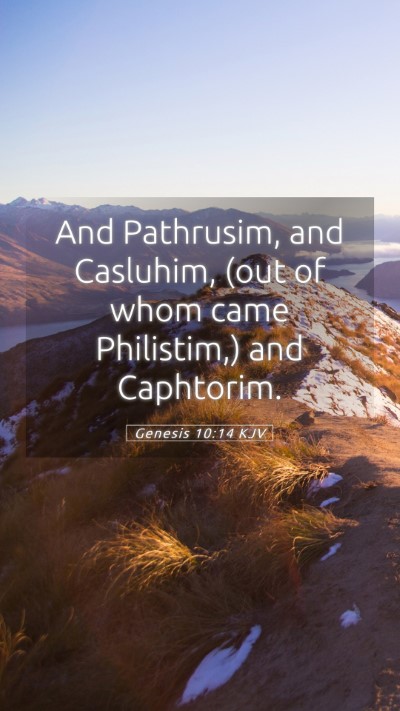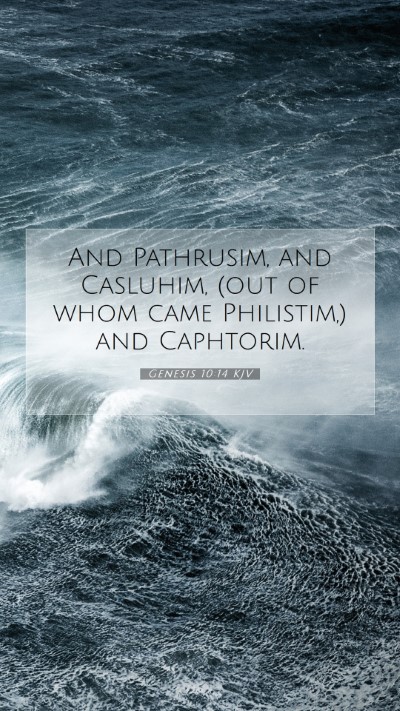Understanding Genesis 10:14 - Bible Verse Meaning and Commentary
Genesis 10:14 states: “And Pathrusim, and Casluhim, (of whom came the Philistines,) and Caphtorim.” This verse is part of a genealogical lineage that outlines the descendants of Noah and serves as an important historical reference to the origins of certain peoples, particularly the Philistines.
Significance of Genesis 10:14
This passage illustrates the completion of the genealogical record following the great flood, showcasing the spread and diversification of humanity. The mention of the Philistines is particularly noteworthy, as they were significant adversaries of Israel throughout biblical history.
Key Insights from Public Domain Commentaries
-
Matthew Henry’s Commentary
Matthew Henry emphasizes the importance of tracing lineages to demonstrate God’s providence in the world. He notes that while the verse may appear as a mere list of names, it reveals the sovereignty of God over nations and the unfolding of His redemptive plan through history. The Philistines, being descendants of the Casluhim, are highlighted as occupying regions that would later come into conflict with the Israelites, underscoring the perpetual tension recorded in the Scriptures.
-
Albert Barnes’ Commentary
Albert Barnes focuses on the geographical aspect, explaining that these names represent actual groups that existed in the ancient Near East. The Casluhim, who are mentioned alongside the Philistines, are linked to the coastal areas of Canaan. Barnes also points out that Caphtor, likely identified with Crete, indicates the seafaring nature of these early peoples and their expansion from the original territories in the post-Flood world.
-
Adam Clarke’s Commentary
Adam Clarke provides an exegetical insight, suggesting that the names listed have linguistic significance and historical implications. He indicates that the Philistines represented a distinct culture with unique practices that often conflicted with Israelite worship and customs. Clarke draws attention to how these genealogies serve not only as historical records but as a means of understanding the cultural and religious dynamics that shaped Israel’s identity in the biblical narrative.
Understanding Scripture Through Context
The genealogical passages in the early chapters of Genesis, including Genesis 10:14, serve an essential purpose. They document the dispersion of humanity post-Babel and the establishment of various nations with their corresponding identities. This historical context enriches our Bible verse understanding and helps us see the flow of God’s plan from creation to the emergence of Israel as a chosen people.
Application of Genesis 10:14 to Daily Life
While Genesis 10:14 may seem obscure at first glance, it challenges us to consider our own lineage—both spiritual and physical. Just as God was orchestrating the relationships and conflicts of ancient peoples, He remains sovereign in our lives today. Understanding our backgrounds, the histories of our families, and the spiritual legacies we inherit can deepen our walk with God.
Related Bible Cross References
- 1 Samuel 5:1-2 - The Philistines capture the Ark of the Covenant.
- Amos 9:7 - A reference to the Philistines as a people known to God.
- Genesis 10:15 - Further details on the descendants of Ham, including the Canaanites.
Further Study Resources
For those engaged in Bible study groups or looking for Bible study resources, understanding genealogies can offer fruitful discussions. Utilizing Bible study tools like commentaries, dictionaries, and historical maps may enhance your knowledge and provide a more profound insight into understanding difficult Bible passages.
Conclusion
In summary, while Genesis 10:14 offers a glimpse into historical genealogies, it invites us to reflect on God's sovereignty and the unfolding of His divine plan. Engaging with Scripture through in-depth analysis, like this verse, fosters a richer understanding of the Bible and equips us for both Bible study lessons and practical applications in our lives today.


